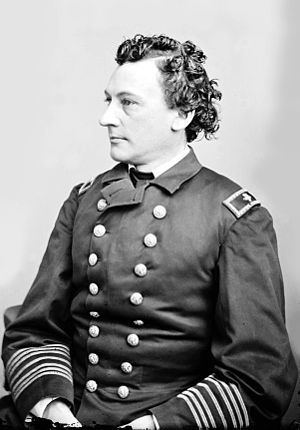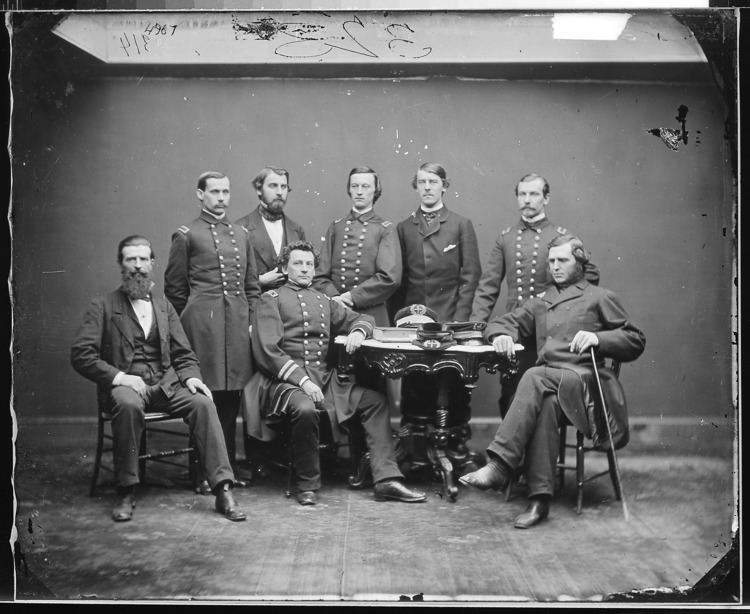Allegiance United States Role Engineer Name Benjamin Isherwood | Rank Rear Admiral Years of service 1844–1884 Service/branch Union Navy | |
 | ||
Born October 6, 1822New York City ( 1822-10-06 ) Battles and wars | ||
Benjamin Franklin Isherwood (October 6, 1822 – June 19, 1915) was an engineering officer in the United States Navy during the early days of steam-powered warships. He served as a ship's engineer during the Mexican–American War, and after the war did experimental work with steam propulsion. Rising to the rank of rear admiral, as Engineer-in-Chief of the Navy during the Civil War, he helped to found the Navy's Bureau of Steam Engineering.
Contents
- Career in civilian engineering
- Early Naval career
- Civil War
- Post war activities
- Legacy
- Selected publications
- References

Career in civilian engineering
Isherwood was born in New York City. He worked for the Utica and Schenectady Railroad and trained under William C. Young, one of the most prominent engineers of that period. Isherwood then worked on the Croton Aqueduct, followed by an engineering job on the Erie Canal. Designing and constructing lighthouses for the Treasury Department was Isherwood's last employment before joining the Navy.
Early Naval career
At the age of 22, Isherwood was appointed First Assistant Engineer in the Navy May 23, 1844, serving aboard General Taylor in 1846–47. During the Mexican–American War, he served in the steam warship Princeton, and later was senior engineer of the gunboat Spitfire.
When the Mexican–American War ended, Isherwood was assigned to the Washington Navy Yard, where he assisted Charles Stuart in designing engines and experiments with steam as a source of power for propelling ships. Throughout the 1850s, Isherwood compiled operational and performance data from steam engines in U.S. and foreign commercial vessels and warships. He used these empirical data to analyze the efficiency of engine types then in use.
In the twelve years between the Mexican–American War and the Civil War, Isherwood published 55 technical and scientific articles on steam engineering and vessel propulsion in the prestigious Journal of the Franklin Institute. In 1859 the engineer published the results of his own original thermodynamic experiments in the two-volume Engineering Precedents for Steam Machinery. Isherwood was the nation's most prolific antebellum technical writer.
Isherwood went to sea during the period between the wars, serving as Chief Engineer of the steam frigate San Jacinto on a cruise of more than three years on the Asiatic Station. During this cruise he was stricken with dysentery, prompting his return to the United States.
Civil War
Shortly after the outbreak of the Civil War, Isherwood was appointed Engineer-in-Chief of the Navy, and so important were his services considered that the Bureau of Steam Engineering was created under his direction.
When the Civil War began, the Navy had 28 steam vessels, and during the war, the number grew to 600. Isherwood conducted the design and construction of the machinery necessary to accomplish this. He designed ships that were fast enough to pursue the blockade runners.
In 1863 and 1865, Isherwood published the first and second volumes of Experimental Researches in Steam Engineering, which were translated into six languages and became a standard engineering text upon which future steam experimentation was based.
Post-war activities
Immediately upon the conclusion of the war, Isherwood was principally involved with organizing a new scientific curriculum for steam engineering at the United States Naval Academy at Annapolis. By 1874, naval engineers refined this curriculum to the point that it served as the model for mechanical engineering education at most American universities.
In 1869 Isherwood ran afoul of former Spitfire shipmate Admiral David Dixon Porter. During the war years Isherwood led a campaign to increase the rank and influence of engineering officers in the navy. Porter opposed this change in the service's class structure. After the presidential inauguration of Ulysses S. Grant, Isherwood's longtime patron, Secretary of the Navy Gideon Welles, could no longer protect him. Admiral Porter banished Isherwood to the Mare Island Navy Yard in San Francisco.
Despite his diminished stature, Isherwood continued to produce technical innovations. In 1870 and 1871, Isherwood conducted experiments that resulted in a propeller that was used by the Navy for the next 27 years.
He was a pioneer in the production of fast cruisers, producing this class against strong opposition. Following a tour of European dockyards, he became president of the Experimental Board under the Bureau of Steam Engineering until his retirement on October 6, 1884.
Isherwood died in New York City at the age of 92.
Legacy
The Navy has recognized Isherwood's contributions in various ways. Isherwood Hall, built in 1905 on the campus of the United States Naval Academy, was the home of the Department of Marine Engineering. It was razed in 1982 to make space for the Academy's new Alumni Hall. Isherwood's name lives on as the new hall's Isherwood Entrance.
The Rear Admiral Benjamin F. Isherwood Award is awarded by the Navy to recognize "innovation and expertise in the effective assessment, development, execution, or deployment of technological solutions for operational Fleet needs."
Three U.S. Navy ships – two destroyers named USS Isherwood and the never-finished fleet replenishment oiler USNS Benjamin Isherwood – have been named for him.
In a 1941 article in the United States Naval Institute's Proceedings, George W. Dyson stated that Isherwood might possibly be the greatest engineer the United States Navy had developed.
The revolutionary engineering program initiated by Isherwood at the U.S. Naval Academy became the template for professional American mechanical engineering education. That basic curriculum designed at Annapolis in the late 1860s and early 1870s still serves as the core of university mechanical engineering pedagogy.
